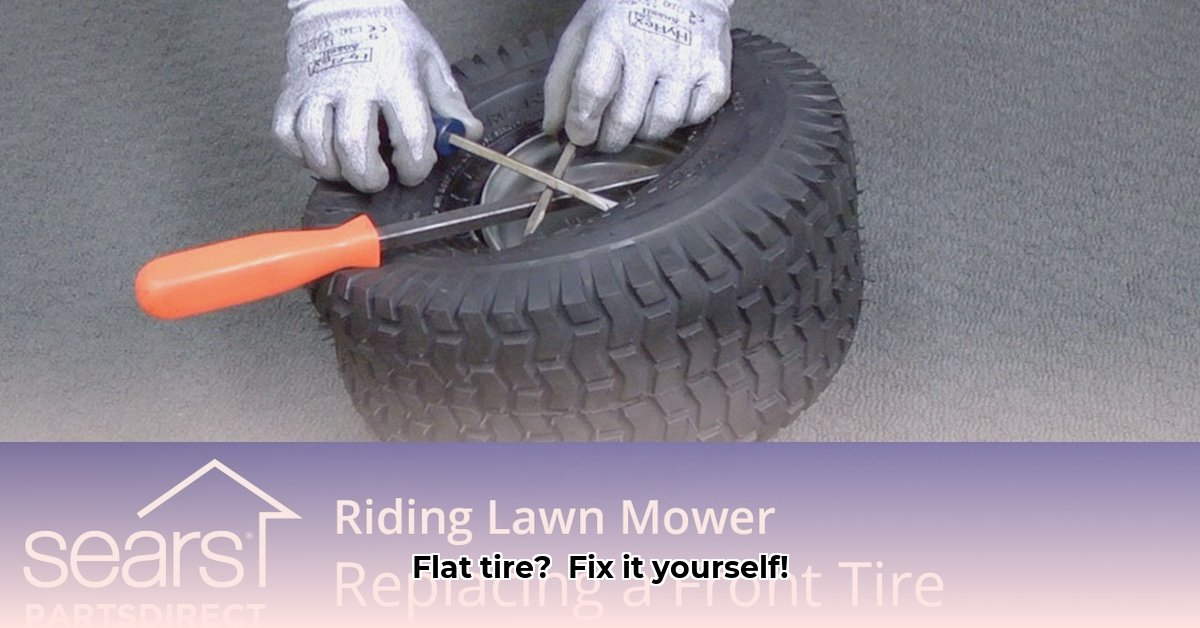
How to Change a Lawn Tractor Tire: A Step-by-Step Guide
Changing a lawn tractor tire can seem intimidating, but with the right tools and this guide, it's a manageable DIY project. This step-by-step instruction empowers you to get back to mowing your lawn quickly and efficiently. For more tire information, see our helpful guide on lawn tractor tire tubes.
Essential Tools for the Job
Before you start, gather these essential tools:
- Jack: Rated for your lawn tractor's weight. (Choose the correct weight capacity to prevent accidents)
- Jack Stands: Absolutely crucial for safety; never work under a raised tractor without them.
- Wheel Chocks: Securely wedge these behind the wheels to prevent rolling.
- Lug Wrench: To remove and tighten the lug nuts.
- Tire Iron: For prying the tire off the rim. (This tool helps separate the tire from the wheel rim)
- Air Compressor or Hand Pump: To inflate the new tire.
- Pressure Gauge: To accurately check the tire pressure—critical for proper tire life and mower performance.
- Gloves: To protect your hands.
- Liquid Soap (optional, but highly recommended): Acts as a lubricant for easier tire mounting and dismounting.
Did you know that using liquid soap during tire changes is a common mechanic’s trick to reduce friction and make the job much smoother?
Step-by-Step Tire Change Instructions
1. Prioritize Safety: Park your tractor on level ground, engage the parking brake firmly, and use wheel chocks. Safety is paramount. A moving tractor is extremely dangerous.
2. Lift Safely: Position the jack under the frame near the flat tire. Slowly raise the tractor until the wheel is off the ground. Immediately place jack stands securely under the frame, next to the jack. Lower the tractor onto the jack stands. Never work under a raised tractor supported only by a jack.
3. Loosen Lug Nuts: Before lifting, slightly loosen the lug nuts. This makes removal easier once the wheel is raised. Remove the nuts completely after raising and securing the tractor.
4. Remove the Tire: Use the tire iron to pry one edge of the tire bead (the edge of the tire) away from the rim. Apply liquid soap liberally. Work your way around the entire tire, prying gently but firmly. This step may require patience and some effort. Two people can often make this task easier.
5. Inspect the Components: Before mounting the new tire, inspect the rim and valve stem for any damage. Clean away any dirt or debris.
6. Mount the New Tire: Carefully place the new tire onto the rim, ensuring it's evenly seated. This step often benefits from a second pair of hands. Use liquid soap to minimize friction.
7. Reinstallation and Tightening: Align the wheel with the wheel studs, push it firmly onto the studs, and hand-tighten the lug nuts. Lower the tractor, supported by the jack stands.
8. Inflate and Final Tightening: Remove the jack and jack stands. Inflate the tire to the manufacturer's recommended PSI (check your owner's manual). Tighten the lug nuts securely with the lug wrench.
Troubleshooting Common Problems
- Stuck Tire: If the tire is difficult to remove, use more liquid soap, work more slowly, and consider enlisting help. Persistence and lubrication are key.
- Incorrect Tire Size: Always verify that the new tire is the correct size for your lawn tractor. Using the wrong size can cause serious problems.
- Damaged Parts: If you notice damage, replace the affected components before reinstalling the wheel. Driving with damaged parts is extremely hazardous.
Lawn Tractor Tire Maintenance Tips
Regular tire pressure checks are vital for optimal performance and tire lifespan. Consistently under-inflated tires wear out quickly. Consider investing in high-quality tires for improved longevity.
Remember: If you're unsure about any step, consult your owner's manual or seek professional help. With careful attention to detail, you can successfully change your lawn tractor tire and get back to mowing!
How to Fix a Lawn Mower Tire That Won't Seat Properly
This section addresses a common issue: a tire refusing to seat on its rim. This usually stems from new tires compressed during shipping or older ones that have lost flexibility.
Methods for Seating a Stubborn Tire
All methods should be performed with the tractor safely secured.
1. Leverage Method: Use ratchet straps or rope to leverage the tire bead over the rim. This gradual approach is effective for slightly stubborn tires.
2. Soap and Water Method: Lubrication helps the bead slide into place more easily. Apply soapy water to the bead before using leverage.
3. Temporary Inner Tube Method: This helps seat the bead on severely flattened tires. Inflate a temporary inner tube to expand the tire, then use the leverage method.
4. Seek Professional Help: If these methods fail or damage is present, seek professional assistance.
Safety First
- Never use flammable liquids.
- Always use proper support when working on the tires.
- Wear safety glasses.
- Inflate the tire gradually.
Troubleshooting Stubborn Tires
If the tire is too tight, verify the correct tire and rim sizes are being used. Inspect the rim for damage. For extremely stubborn tires, persistence and multiple attempts are sometimes required. Remember to always prioritize safety and consult your owner's manual or a mechanic if needed.